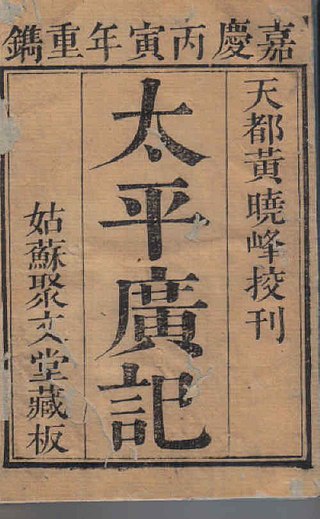Top Qs
Timeline
Chat
Perspective
Taiping Guangji
9th-century Chinese collection of writings From Wikipedia, the free encyclopedia
Remove ads
The Taiping Guangji (Chinese: 太平廣記), sometimes translated as the Extensive Records of the Taiping Era or Extensive Records of the Taiping Xinguo Period, is a collection of stories compiled under the second emperor of the Song dynasty, Taizong.[1] The work was completed in 978, and printing blocks were cut, but it was prevented from official publication on the grounds that it contained only xiaoshuo (fiction or "insignificant tellings") and thus "was of no use to students." It circulated in various manuscript copies until it was published in the Ming dynasty.[2] It is considered one of the Four Great Books of Song (宋四大書). The title refers to the Taiping Xinguo era (太平興國, "great-peace rejuvenate-nation", 976–984 AD), the first years of the reign of Taizong.[3]

The collection is divided into 500 volumes (卷; Juǎn) and consists of about 3 million Chinese characters. It includes 7,021 stories selected from over three hundred books and novels from the Han dynasty to the early Song dynasty, many of which have been lost. Some stories are historical or naturalistic anecdotes, each is replete with historical elements, and was not regarded by their authors as fiction, but the topics are mostly supernatural, delving into tales about Buddhist and Taoist priests, immortals, ghosts, and various deities. They include a number of Tang dynasty stories, especially chuanqi (tales of wonder), that are famous works of literature in their own right, while also being the inspiration for later works. [2]
In the 17th century, the vernacular novelist and short story writer Feng Menglong produced an abridged edition, Taiping Guangji Chao (太平廣記鈔), reducing the number of stories to 2,500 in 80 volumes.[4]
Pu Songling was said to have been inspired by Taiping Guangji; the short story "A Sequel to the Yellow Millet Dream" parallels one of Taiping's stories.
Remove ads
Contents
The Taiping Guangji was compiled by Wang Kezhen (王克贞), Song Bai (宋白), Hu Meng (扈蒙), Xu Xuan (徐铉), Zhao Linji (赵邻几), Lü Wenzhong (吕文仲), Li Fang (李昉), Li Mu (李穆), and others.
Translations
- Into the Porcelain Pillow: 101 Tales from Records of the Taiping Era, translated by Zhang Guangqian (Foreign Languages Press, 1998)
- Tales from Tang Dynasty China: Selections from the Taiping Guangji, translated by Alexei Ditter, Jessey Choo and Sarah Allen (Hackett Publishing Company, 2017).
- The Tale of Li Wa by Bai Xingjian, translated as The Story of Miss Li by Arthur Waley in More Translations from the Chinese (Alfred A. Knopf, 1919)
- The Tale of Liu Yi, translated as The Dragon King's Daughter by Yang Xianyi and Gladys Yang in The Dragon King's Daughter: Ten Tang Dynasty Stories (Foreign Languages Press, 1954)
- Huo Xiaoyu's Story by Jiang Fang, translated by Stephen Owen in An Anthology of Chinese Literature: Beginnings to 1911 (W. W. Norton & Company, 1996)
Remove ads
References
Sources
Wikiwand - on
Seamless Wikipedia browsing. On steroids.
Remove ads
